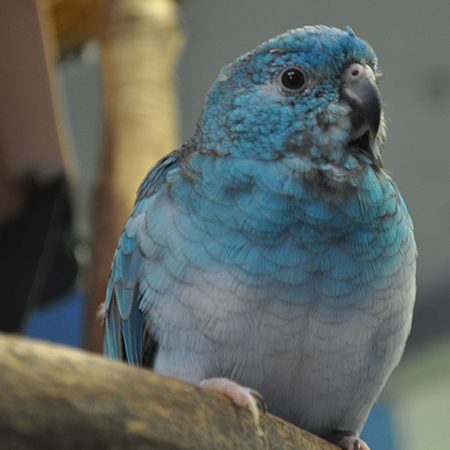Red Rump Parakeet
Psephotus haematonotus
The Red Rump Parakeet is known by many names, including Red-backed Parrot, Grass Parrot, Ground Parrot, and Green Leek. They have primarily green to blue coloring, with only the adult males that actually have a red patch on their rump. Yellow feathers appear on their underbellies, which is usually brighter in males. Their tails tend to be very long, almost matching their body length, putting their length at just less than a foot. They weigh only 2-3 ounces. Unlike other parrot species, they do not learn to mimic voices, but rather just produce high pitched trills and whistles. They live, on average, for over a decade in captivity, but have been known to live up to 30 years.
These active birds prefer open areas where they have plenty of space to fly around. They are very energetic during the day, flying around constantly to protect their territories. Because of their upbeat personalities and vibrant colors, they are becoming popular pets to have. Different colors have been bred as well, so there are now yellow forms of these birds.

Red Rump Parakeets are found in parts of Australia, ranging across New South Wales and south-western Queensland.
HABITAT -They are found in woodlands and grasslands of southern Australia.
DIET -They mainly eat grass seeds in the wild, as well as fruit and insects.
FUN FACT -Although rare, there have been some red-rumped parakeets that have learned to mimic human speech.
SOCIAL BEHAVIOR -They are fairly shy to humans and will live in small groups only if space allows.
ACTIVITY -They are diurnal being most active during the day and resting during the evening.
PREDATORS -Large carnivores or birds of prey are known to hunt them.
SIZE -They weigh only a few ounces and grow to just under a foot long.
RELATIVES -They are related to other parrots, such as the Gray Parrot or Indian Ringneck Parakeet.
CONSERVATION -They are listed as LC (Least Concern) according to the IUCN.
Cub Creek Animal Care Information
Housing - All of our red rumps live in Lemur Landing, our large lemur enclosure in the dining hall! They are given lots of space to fly and trees to perch on, just like they would have in the wild. The ground is covered in mulch that can absorb any excrement. There is also a fountain in their enclosure that they can climb on or use as a bird bath.
Diet - These birds are fed ZuPreem FruitBlend medium bird pellets that give them all the vitamins and nutrients they need to be healthy. They also get fresh bird salad daily, which includes apple, shredded sweet potato, and greens. There are several bowls that allow them access to fresh water.
Enrichment - These birds get most of their enrichment through living in a multi-species enclosure. Not only is there lemurs, but also Ringneck Parakeets, bettongs, and sometimes tortoises. Between these interactions and the many places in the large enclosure to explore, these birds have plenty to do everyday.

